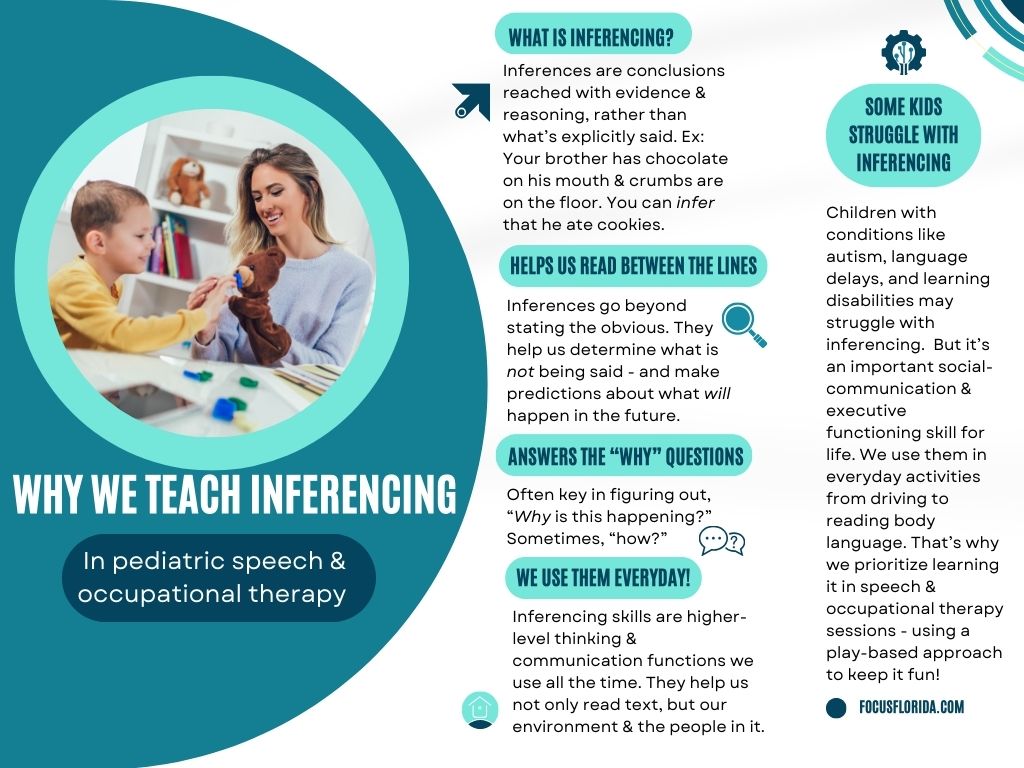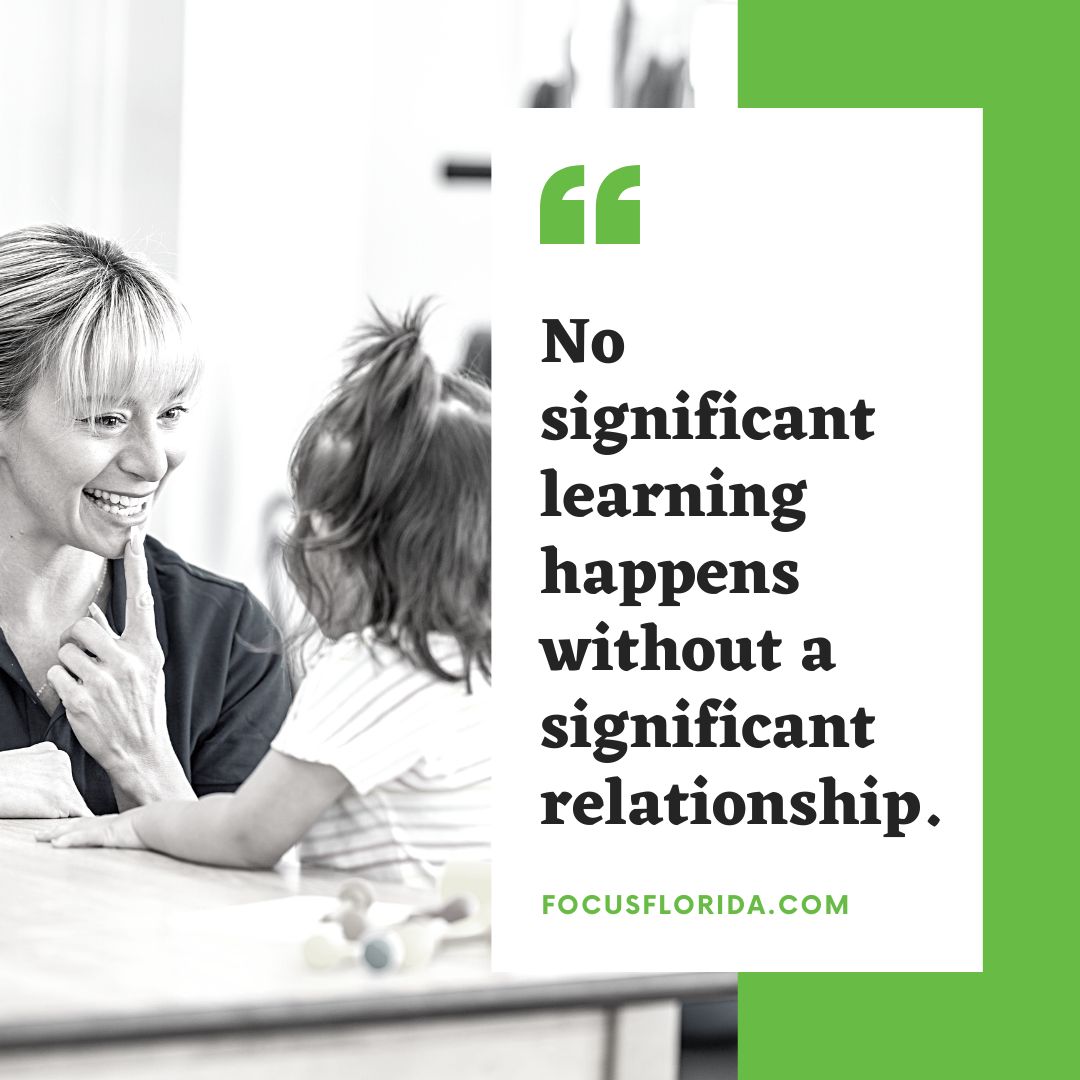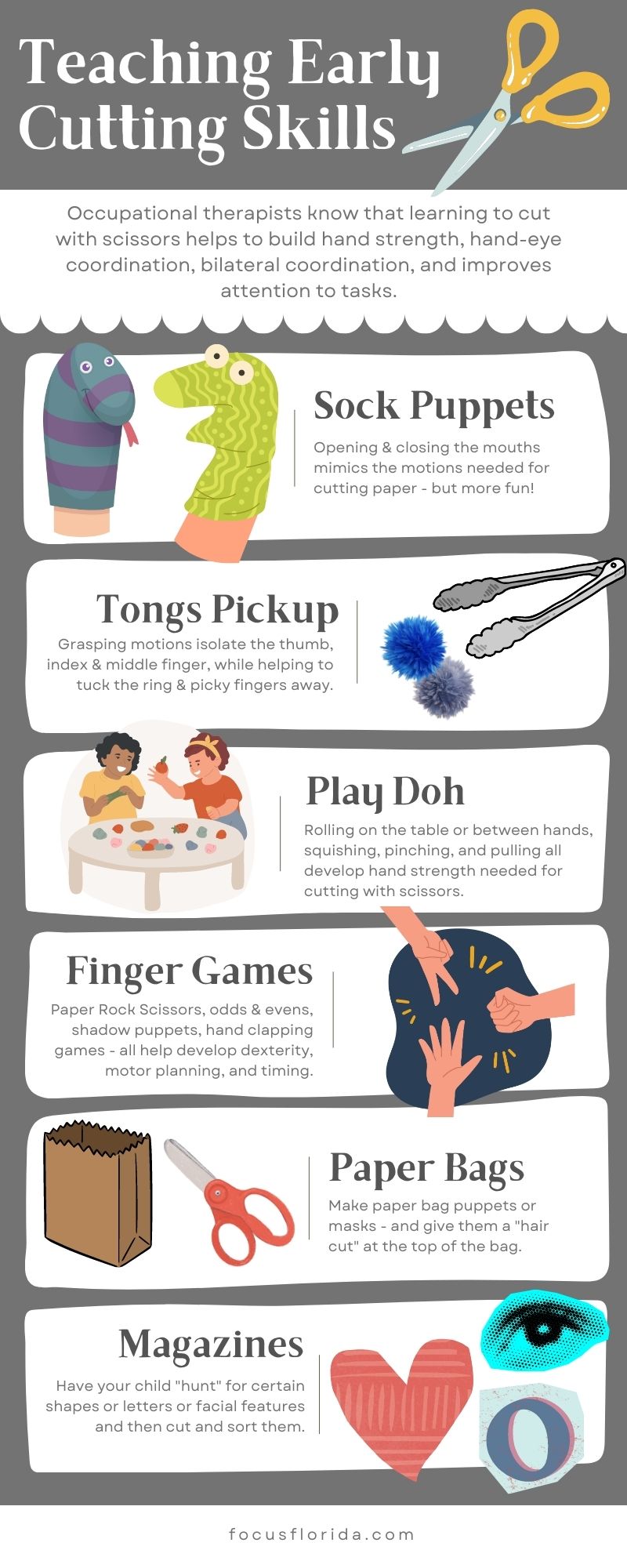Blog
Why Occupational & Speech Therapists in Fort Myers Teach Kids Inferencing
Inferencing is often thought of as a “school skill.” But as our occupational & speech therapists in Fort Myers can explain, it’s one that starts to develop long before kindergarten and has far more applications than a language arts class.
In fact, we use inferences so frequently, we often don’t realize we’re even doing it.
Inferencing is a form of logical deduction wherein we make logical guesses about “why” or “how” or “what happens next” – based on available evidence and previous knowledge/experience. It’s more about what is not being said. It’s used all the time – when we’re reading a book (“Is she telling the truth?”), when we’re driving (“what will the guy in the blue Honda do next?”), when we’re talking with a friend (“why do they look so sad?”), or when we’re shopping (“Will Jenny eat these kind of crackers?”).
As pediatric occupational & speech therapists in Fort Myers, we recognize that kids need to be able to u understand the unspoken connection between statements, as well as the meaning behind it all. Children with conditions like autism tend to struggle with “reading between the lines” and understanding concepts beyond what is literal and tangible. By explicitly teaching and reinforcing inference-making in our therapy sessions, we help them with goals like reading comprehension, reading engagement, and overall improved metacognitive thinking.
FOCUS offers pediatric occupational & speech therapy in Fort Myers and throughout Southwest Florida. Call (239) 313.5049 or Contact Us online.
Additional Resources:
Explaining Reading Comprehension in Children With Developmental Language Disorder: The Importance of Elaborative Inferencing, Oct. 26, 2018, Journal of Speech, Language, and Hearing Research
More Blog Entries:
Screen Time Speech Delays = Higher Speech Therapy Fort Myers Demand, Aug. 24, 2023, Southwest Florida Speech Therapy Blog
Update: FOCUS Therapy to Re-Open Thursday, Aug. 31st
In following the lead of the Lee County School District, FOCUS Therapy will resume in-clinic sessions with our patients on Thursday, Aug. 31st.
Weather-related concerns due to Hurricane Idalia are no longer pertinent to our area in Fort Myers / Southwest Florida.
We continue to pray for the safety & well-being of everyone in the path of the storm. 💚
- Categorized: FOCUS News
Important Announcement From FOCUS Therapy
Due to the anticipated tropical force winds in our area from Hurricane Idalia, FOCUS Therapy is closed Wednesday, August 30th. We follow the lead of the Lee County School District. A decision about whether to open Thursday, Aug. 31st should be announced sometime this afternoon.
We are praying for the safety & well-being of everyone in this storm’s path. ![]()
- Categorized: FOCUS News
Screen Time Speech Delays = Higher Speech Therapy Fort Myers Demand
- focustherapy
- Aug 24, 2023
- Comments: ( 1 )
A recent study published in the Journal of the American Medical Association Pediatrics showed that when 1-year-olds are exposed to 4+ hours of screen time daily, they experience developmental delays in speech-language communication and problem-solving skills. In turn, we’re seeing even demand for those seeking speech therapy Fort Myers creep every higher.
We note this for two reasons (neither of which is to shame parents for screen time habits because – look, we get it!). But we think it’s important to note that:
- The more you can prioritize face-to-face interactions and communication over screen time – particularly with babies, toddlers, and very young children – the better.
- If you do suspect a delay in communication skills, it’s not in your child’s best interests to “wait and see.” For one thing, delaying early intervention services like speech therapy Fort Myers often only results in compounding the child’s speech-language deficits. But beyond that, with more kids than ever needing services, the waitlists are likely to be longer. The sooner you get the ball rolling, the faster you can secure the services that will help ensure your child thrives.
Also, it’s worth pointing out that the study didn’t expressly conclude that it was excess screen time that directly caused developmental delays among toddlers. In fact, the researchers theorized that the pattern probably had more to do with the fact that face-to-face time is so valuable for babies and young children, and those with 4+ hours of time on screens are getting less of that. This is why rather than admonishing anyone about their kids’ screen use, our Fort Myers speech therapists underscore the importance of time spent just talking, singing, and generally interacting with your child.
The Value of “Face Time” With Your Young Child
As pediatric speech therapists, we are closely familiar with the fact that early interactions play a critical foundational role in shaping a child’s communication skills, cognitive development, emotional understanding, and social engagement. Face-to-face interactions provide a rich and dynamic environment for learning and growth.
They are essential for fostering healthy development in the following ways:
FOCUS Therapy Prioritizes Therapist Relationships With Patients & Parents
At FOCUS Therapy, one of the first things we do when starting speech, occupational, or ABA therapy with a new patient is make it a point to begin building a positive relationship with the child and their parents/caregivers.
The fact is, genuine connection and trust are the foundation upon which successful therapy is built. Without that, progress on important goals would always be lacking. For any pediatric therapy to work, the child has to be engaged, invested, and excited to learn. They also must trust their therapist with their physical, mental, and emotional well-being – because there are times when it can get hard. They need to know that we are always looking out for them, and only pushing their limits because we care about them and want to see them grow and thrive.
We know the only way to establish that kind of bond is to put in the time and effort – working slowly up to tougher tasks, keeping open communication with parents, and letting our genuine love for these kids and this work shine through.
There is actual research to back this up as well. In a 2021 study published in the journal JBI Manual for Evidence Synthesis, researchers found that when therapists have better relationships with their patients, patient outcomes are markedly better!
As FOCUS Therapy owner/founder Jennifer Voltz-Ronco says, “Almost any practical skill can be taught to a person if they work hard enough to learn it. But genuine passion for working with kids – especially those who may be struggling with numerous major challenges – that’s something a person either has or they don’t. So when I hire a pediatric therapist, I’m looking for people who truly care about these children – and come back every day, every week, every month for THEM. THOSE are the people I want on my team.”
FOCUS Therapy offers pediatric speech, occupational, and ABA therapy in Fort Myers to kids throughout Southwest Florida. Call (239) 313.5049 or Contact Us online.
Additional Resources:
Why Regular Speech Therapy Attendance is So Critical to Your Child’s Success, Therapy and Wellness Connection
More Blog Entries:
Water Safety Tips for Florida Kids With Special Needs, June 15, 2023, FOCUS Therapy Blog
- Categorized: FOCUS News
- Tagged: Fort Myers ABA Therapy, Fort Myers occupational therapy, Fort Myers speech therapy
What are Kids’ Occupations? Fort Myers Occupational Therapist Explains
- Categorized: Occupational Therapy
- Tagged: Fort Myers occupational therapy, occupational therapy
Fort Myers IEP Assistance & Planning Help for Middle School Accommodations
At FOCUS Therapy, our practice is mainly centered around early intervention with younger kids. That said, some of our patients continue to work with us through elementary school and beyond. The transition from elementary to middle school can be a big one – and our Fort Myers IEP Assistance & Planning team can help parents advocate for the appropriate school accommodations and modifications.
The term “accommodation” is used to describe an alteration of environment, curriculum format, or equipment that allows someone with a disability to complete assigned tasks or gain access to content. Accommodations allow students to pursue a regular course of study, but they don’t alter what’s being taught. Examples of accommodations our Fort Myers IEP Assistance & Planning team might advocate for are things like extended time for students with learning disabilities or fine motor limitations.
A modification is a change to the curriculum. This is typically extended to students with disabilities who aren’t able to comprehend the content being taught. Examples of accommodations would be things like reducing and substantially modifying the content a child is taught and the tasks they are expected to complete.
Students with a 504 Plan under the Rehabilitation Act of 1973 or an IEP (Individualized Education Plan) under IDEA (Individuals with Disabilities Education Act) are entitled to accommodations and possibly modifications that will allow them to learn to the best of their ability in the least restrictive environment.
The key to academic success for a child with disabilities often comes down to having the right adaptations, accommodations, modifications, and supports in the classroom. These should be individualized for each student, based on their needs, personal learning styles, interests, and abilities. That said, here are some generalized steps our Fort Myers IEP Assistance & Planning team can offer for parents who are getting ready for the upcoming school year:
- Start gathering all relevant information and documentation. Hopefully, your child’s elementary school IEP / 504 Plan team was understanding and did their best to help your child succeed. But middle school is the start of some big changes. That can be intimidating for both parent and child. Doing your best to be prepared can go a long way toward building confidence and allowing you to approach this meeting with a positive attitude and spirit of cooperation with this new team. You should gather your child’s IEP or 504 Plan, their most recent report cards, homework, progress reports, correspondence with teachers or administrators, doctors’ letters, therapy plans-of-care, health care records, standardized tests, evaluations, medication/instruction lists, etc. Include some notes of your own about your child’s performance at school and their behavior.
- Meet with a Fort Myers IEP Assistance & Planning advocate. Once you have all these materials, meet up with an advocate who has experience in planning/creating/modifying IEP and 504 Plans. Many of our FOCUS therapists have background experience in school-based therapy, so we are closely familiar with this process and the school accommodations/modifications that can help the kids we treat. We’ll help you review this information and determine whether we need to continue with the same list of accommodations, or whether the increasing demands of middle school will mean they will need some additional supports. Be prepared to answer questions like: What is your child currently struggling with in school? What goals do you want your child to reach? Is your child going to need more breaks? If so, when/how/with whom will those breaks occur? What accommodations are they going to need in spaces outside the classroom – like the cafeteria, restroom, library, or locker room? How will medications be dispensed if needed? What behavioral or disciplinary practices/methods are used by teachers to deal with students who have special needs? What plans are in place to support my child’s social interaction and growth in recreation/leisure activities? Is there a specific staffer my child can go to if they feel confused/anxious/overwhelmed? Does the school’s emergency evacuation plans take into account the unique needs of my child? What channels of parent communication will be available if issues or concerns arise?
- Approach the meeting with a spirit of cooperation. Our team is here to help and support you however we can. We understand the IEP and 504 Plan processes can be overwhelming and even frustrating for parents. Your first inclination may be to go into it as if you’re facing off with an adversary, guns blazing. However, it’s our experience that approaching the school district team with a positive attitude and a spirit of cooperation is often the most successful. Don’t be afraid to vocalize concerns and push back when you disagree – but if you can do so respectfully and even kindly, chances are better that you’ll have greater success. We can come to the meeting with you to ensure you are heard.
- Prepare your child. Middle school is a big change – and that goes for all kids. Those with disabilities may find the transition even tougher. Take some time to prepare them for the switch. Consider giving them a middle school t-shirt and maybe take them to a school sporting event, play, or concert so they feel more connected to the community. Discuss the upcoming school year with your child, and ask if they have any concerns. Drive by the school a few times so they get used to seeing it. Ask the school if you can take a tour in advance, maybe even meet some of the teachers and staff. If there’s an orientation, take your child. And talk to other parents of middle school kids with IEPs and 504 Plans – they can be great resources!
FOCUS offers pediatric speech, occupational, physical, and ABA therapy in Fort Myers and throughout Southwest Florida. Call (239) 313.5049 or Contact Us online.
Additional Resources:
More Blog Entries:
Understanding Sensory Processing Disorder Subtypes Sept. 1, 2022, Fort Myers IEP Assistance & Planning Team
Autism & Fireworks: Tips From Fort Myers Occupational Therapists
For many people, fireworks are the highlight of summer holiday celebrations. But as Fort Myers occupational therapists, we recognize that delight isn’t what these loud, bright, earth-shaking explosions inspire for everyone. For neurodiverse individuals – and kids on the autism spectrum, in particular – fireworks can be scary, stressful, and uncomfortable.
Every child is different, so the approach parents and loved ones take to minimize these negative impacts will vary from person to person. Some parents may opt out of attending these events entirely. This is understandable. A 2018 study published in the peer-reviewed journal IEEE Pulse (Institute of Electrical and Electronic Engineers) took note of hypersensitivity to noise among many children with autism, underscoring that even everyday noises can sometimes cause pain, anxiety, and meltdowns. Absolutely if this is the case, it’s best to keep your child far from fireworks displays if at all possible.
But for those who think their child might truly get some enjoyment from it – as long as they’re prepared – consider the following tips from our Fort Myers occupational therapists.
Keeping Your Kid Comfortable During the Display
To keep your child calm and comfortable during fireworks, it’s actually a good idea to start planning several days or even weeks in advance.
Water Safety Tips for Florida Kids With Special Needs
Water is a way of life in Florida, but drowning is the No. 1 cause of death among children under 5 in the Sunshine State. Children with special needs (particularly those with conditions like autism that make them prone to wandering) are at especially high risk. At FOCUS Therapy, we want to ensure all our patients and families stay safe this summer. It is imperative that parents and caregivers be proactive about water safety.
Learning to swim is one of the best prevention methods. If they are too young yet to learn, ISR swim lessons can be a literal life-saver. ISR stands for Infant Swimming Resource, and it’s a self-rescue program that teaches infants and young children how to survive if they fall into a pool or other body of water.
Taking precautionary measures to prevent wandering is also important. (Think locks, gates, alarms, etc.) Never allow your children to swim unsupervised – even for short stretches, and even if they have floaties. A child under 30 pounds can drown in just 30 seconds. It literally happens that fast, and it’s often very quiet. If you know you’re going to be distracted and around a body of water with your child, recruit others to help you keep an eye on the kid(s) – so that someone is always watching them near water.
If you have questions or need help with teaching your child with special needs about water safety, we can help.
FOCUS Therapy offers ABA therapy, ADOS testing, speech therapy, and occupational therapy to children in Lee County, Florida.
Additional Resources:
Swim and Water Safety, September 2018, Autism Speaks
More Blog Entries:
Break Those Bad Screen Time Habits With These Tips From FOCUS Therapy, March 17, 2023, Fort Myers Pediatric Therapy Clinic Blog
- Categorized: FOCUS News
- Tagged: autism water safety, water safety special needs kids
Teaching Kids Early Cutting Skills
FOCUS Therapy offers occupational therapy to children in Lee County, Florida. Call (239) 313.5049 or Contact Us online to schedule an assessment or inquire about our pediatric therapy services.
- Categorized: Occupational Therapy
- Tagged: cutting skills, preschool cutting practice, preschool cutting skills










